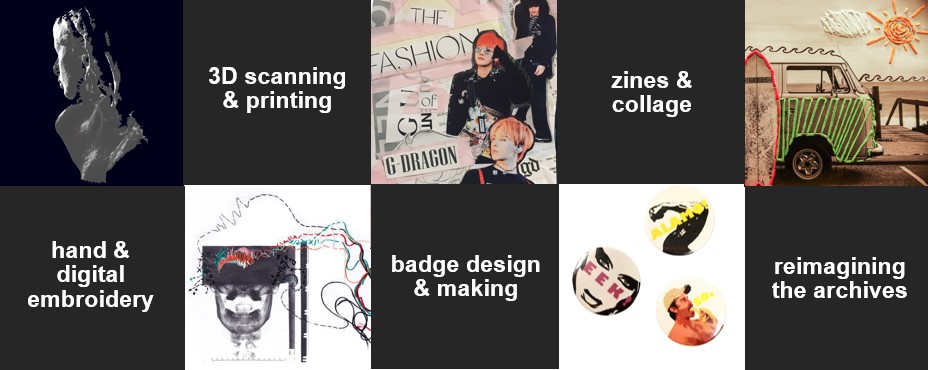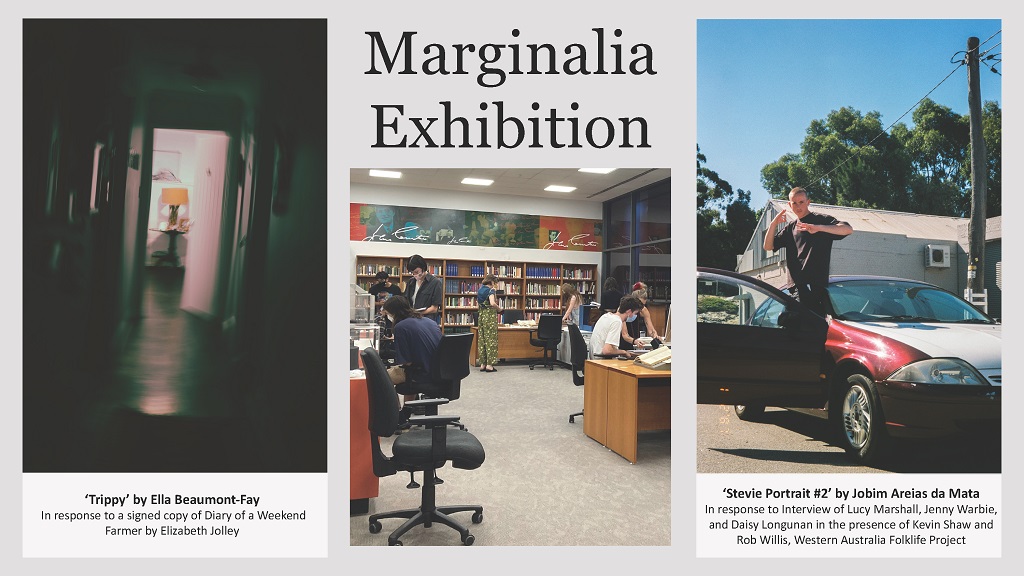Blog
Cultivating creativity
September 6th, 2022 by Kirsten Category: Articles

By Kirsten Hudson
A Collaborative Partnership
Since 2016, the Curtin Library Makerspace and Kirsten Hudson, Lecturer, Faculty of Humanities, have nurtured a collaborative partnership to incorporate the Makerspace into undergraduate coursework across the areas of Cultural Studies, Creative Arts, Photography and Illustration, and Screen Arts. Starting from the position that Makerspaces are uniquely located for the transdisciplinary and critical work of decolonising academic institutions and practices, throughout these collaborations, we have foregrounded the role of contemporary libraries as activist spaces for transformative interdisciplinary collaboration, co-creation, and critique, rather than colonising gatekeepers of knowledge. Grounding learning outcomes in a “maker ethos” whereby attitudes, skills, knowledge, commitment, and competencies are seen as always already open to recombination, revision, reflection, and reciprocity, we have sought to create a modern curriculum that excites both students and staff about the transformative learning dimensions of making and tinkering for all aspects of life-long learning, regardless of the context, discipline or outcome.
Makerspace as a 21st Century Learning Space
We believe deep learning happens when passion and fun are combined with personal purpose and individual investment. We see Makerspaces as deep-learning environments where the rigorous application of arts, crafts, and design, structured with the right pedagogical framework, offers process-oriented, experiential learning opportunities, which not only appeal to neurodiversity and non-western communication, but also facilitates ways of approaching information, problems, and experiences in unexpected, yet relevant ways. By their very design, we understand Makerspaces as safe accepting environments that celebrate difference (individual, discipline, other) due to their inviting nature (architecturally open, ideologically accepting, disciplinary intermingled, technologically interwoven), such that students’ (and staff) are supported in recognising and communicating their own unique positionality in a way that moves beyond language and into a space of transformative reciprocity and co-creation that can grow and evolve over time. By setting a tone of approachability and acceptance underpinned by curiosity, aspiration and possibility, we encourage students and staff to embrace both vulnerability and failure and through a range of activities, demonstrate the transformative potential of flearning - learning through failure! We have found that as students and staff come to recognise and embrace the power of this self-generating system of reciprocity, knowledge co-creation, flearning, friendship and connection, hierarchies of power break down, and everyone becomes more invested in actively contributing to the circularity, creation, and transference of knowledge.
Bodies of Work – A Selection of Units and Activities since 2016.
-
Pleasure, Power, and Popular Culture (2016-2019) – Cultural Studies Major/Primary and Secondary Education Major (1st year core unit) – Badge making, zine making, 3D printing, re-mix/mashups.
-
Image Concepts (2019- ongoing) – Photography and Illustration Major (3rd year core unit) – collage as research method/mapping.
-
PhotoMedia (2020- ongoing) - Photography and Illustration Major (1st year elective) – expanded photography - 3D printing, laser cutting, digital embroidery, circuit, print transfers.
-
Image Design Culture (2022 – ongoing) - Photography and Illustration Major (2nd year core unit) – semester long creative research project collaboration with JCPL Archives.
-
Experimental Screens (2017-2018) – Screen Arts Major (2nd year core unit) – noise music
-
Creative Arts Practice (2020 – ongoing) – Bachelor of Creative Arts (1st year core unit) – sand art, Lego mapping, dioramas.
Pleasure, Power, and Popular Culture (1st Year) - Badge Making, Zine Making, 3D Printing, Mashups/Remixes.
Between 2016-2019 the first year core Culture Studies and Primary/Secondary Education Major unit Pleasure, Power and Popular Culture visited the Curtin Makerspace for a badge-making workshop, a zine-making workshop, 3D printing workshop and finally a remix/mashup workshop. Over the course of the four years that the unit ran, each semester we added in a new activity/visit to the Makerspace that allowed students to grapple with the concepts units in a practical way. We started in 2016 with badge making, and when that was a success, we then added in zine making in 2017, 3D printing in 2018, and Remix/Mashups in 2019.

As this unit was designed to get students “doing” Cultural Studies in a manner that positioned popular culture as a site and object of struggle, we introduced each of the activities facilitated in the Makerspace as ones that had no “right” or “wrong” way to engage. Rather, we premised a successful learning outcome as students actively participating in a variety of popular culture forms and practices, reflecting upon what they
thought and felt before, during and after the experience in a journal form of their choice, as well as thinking about how the materials, practices in the activities might relate (however tangentially) to the concepts and ideas found in the units lectures, readings, discussions and materials. At the start of each activity, we openly talked about the reality that some of the activities might bore or overwhelm the students, or that they might give the students joy or pleasure. We were clear that there might be times when students would struggle to understand their relevance or intent, and that this was okay, and should be the starting point for conversation. However, we kept coming back to the fact that regardless of the thoughts and feelings that were triggered by the activities in the Makerspace, they were vital learning components of the unit, as they were designed to get students thinking about Cultural Studies as an active embodied, materials praxis concerned with, to quote Lawrence Grossberg (2010) teaching students how to describe and intervene “in the ways cultural practices are produced within, inserted into, and operate in the everyday life of human beings and social formations, so as to reproduce, struggle against, and perhaps transform the existing structures of power” (p. 8). Over the four years that this unit ran, students consistently remarked on how powerful the Makerspace activities were in facilitating an understanding of Cultural Studies as an active practice that required them to get involved and get their hands dirty in whatever they were researching.
Image Design Culture (2nd Year) - Whole Semester Creative Research Project Culminating in Exhibition of Images.
This year, for the first time, we conducted a semester long collaboration in the second year core unit of Photography and illustration Major – Image Design Culture. This collaboration was initiated due to a discussion at the end of 2021, where Makerspace indicated they were interested in creative ways of authentically incorporating the John Curtin Prime Ministerial Library Special Collections Archive into an immersive student experience. After a trip to the JCPML archives we were all struck by the variety of materials in the collection that were relevant to the topics in Image Design Culture, and how this unit’s content and structure might provide a productive lens to interpret/revision the archives for a contemporary audience. We were particular excited about the kind of archival “doodles” and interventions in official archival documents that archivists refer to as “marginalia”. As we discussed a range of options for finding an authentic approach for introducing the archives to the students, we reflected on how the world was continuing to unfold in unprecedented ways, and we wondered what it might mean to ask students to consider how photography and illustration (as well as other adjunct image-making practices) might provide unique opportunities to re-look, re-think, re-learn that which exists in the margins. Working with archivist Sally Laming, we put together a select list of 30 artefacts from the collection, which ranged from recorded conversations of WA folklore, to slides of the Jon Sanders Endeavor Project, to Elizabeth Jolley’s diaries.
Working with the theme/concept/practice of MARGINALIA we took the students in Week 1 to the John Curtin Prime Ministerial Library Special Collections Archive, where all 30 of the selected artefacts had been laid out for the students, and we told the students that they were to “speed date the archives”. Timing the students in 2 minute intervals, students moved from archival object to archival object, getting a “feel” of each object and taking notes (in the new journals we gave them on arrival) as to their initial thoughts and feelings of each object. They were encouraged to look/touch/smell the archives and to think about the ones they wanted” to take things further with”. We also asked students to think about why their interest in the artefacts could be of interest to anyone else; what might be gained from sharing their interest or unique interpretation of this artefact with others; as well as how their thoughts, feelings, insights, interpretations of their chosen artefact might matter to culture now, in the 21st century. Our aim was that at the end of the session in the archives, students would select one item from the collection as a starting point from which they would develop their main assessment: a body of creative work and a written 1500 word exegesis that would be publicly exhibited at the end of the semester in an on-campus student gallery. Throughout the semester, we located the weekly class session in the Makerspace so that students could “grapple/tinker with” their chosen artefact using a variety of conceptual and practical lenses relevant to the unit materials and the equipment available in the Curtin Library Makerspace. At the end of the semester, students publicly exhibited unique bodies of work developed over the course of the semester that creatively and insightfully re-interpreted and re-visioned the original archival artefacts for a 21st century audience.

Benefits for the students
Throughout the last seven years, students have consistently commented on the impact collaborating in/with the Makerspace. Comments such as:
-
“There hasn’t been a class this semester which I haven’t had an ah’ha moment in”.
-
“So it’s the end of an era. I have had a lot of fun in this unit. The unit has taught me a lot about the role of popular culture in society, especially the power it has over the individual”.
-
“My discovery of zines not only gave me an outlet to express my thoughts regarding true crime, marginalisation and modes of entertainment but also allowed me to experience and interact with the voice of others, publishing their individual finds in such independent publications”.
-
“I’ve found this to be the most enriching unit I’ve taken at Curtin this year, adding significantly to the cultural language I possess, and allowing me to interpret the world around me in new ways”.
On reviewing the feedback from students across all units that have engaged in various degrees with the Makerspace, they are consistent with regards to expressing themes of fun, insight, connection, the development of new perspectives, and how this all impacts students’ negotiation of their world in a positive manner.
Other positive outcomes
Throughout the last seven years, the ongoing positive impact of this evolving collaboration has been numerous. From an academic perspective, the ability to access resources and equipment not easily accessible or available within faculty has meant that we have been able to practically investigate new ideas in exciting and productive ways we would not otherwise have had the chance to test. Not only has that allowed us as academics to develop new skill sets which benefit our teaching, the ongoing collaboration has also allowed us to establish a relationship where we are able to constantly review, reiterate, and come up with fun new ways to work together every semester. This means that our pedagogical position stays fresh, dynamic, and relevant to new student demographics and industry expectations, but also means that our excitement regarding helping students discover the love of life-long learning is real and fulfilling for us as well.